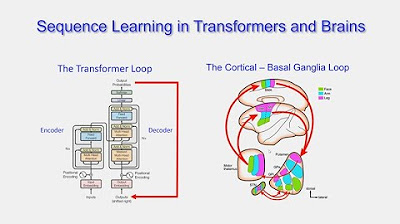Neurofisiología del lenguaje
Summary
TLDRThis video explores the neurophysiology of language, tracing its evolution from early studies of brain lesions by Broca and Wernicke to modern models. It highlights the dual-stream model of language processing, which separates motor and comprehension functions. While the classical Broca-Wernicke theory remains influential, new research using techniques like fMRI offers a more complex view. The left hemisphere primarily handles language in both hearing and sign language, while the right hemisphere contributes to emotional and prosodic aspects. The video underscores the ongoing complexity of language processing and the need for continued research to understand this intricate brain function.
Takeaways
- 😀 Humans have two main characteristics for language: manual dexterity and the ability to speak and write.
- 😀 Language allows for the comprehension, formulation, and transmission of ideas through verbal symbols and sounds.
- 😀 Early studies of language and the brain focused on necropsies of patients with language disorders.
- 😀 The work of Pierre Paul Broca and Carl Wernicke led to the creation of the Wernicke-Broca language circuit.
- 😀 The Wernicke-Broca model, while foundational, is now considered oversimplified and possibly incorrect in some respects.
- 😀 Broca’s aphasia affects speech production, while Wernicke’s aphasia impacts comprehension and leads to nonsensical speech.
- 😀 Global aphasia is a severe condition affecting both language comprehension and production.
- 😀 Language functions are primarily lateralized to the left hemisphere of the brain for both right- and left-handed individuals.
- 😀 The right hemisphere also plays a crucial role in processing prosody, which includes emotional tone and inflection in speech.
- 😀 Newer models, such as the dual-stream model, suggest two distinct circuits for language: a dorsal one for motor functions and a ventral one for comprehension.
- 😀 Despite advancements in research, the complexity of language processing in the brain means much more investigation is needed to fully understand it.
Q & A
What are the two basic characteristics that define humans in relation to language?
-The two basic characteristics are the ability to use hands and the ability to use spoken and written language.
What was the focus of early research on language-related brain structures?
-Early research focused on studying brains from patients with language disorders, primarily through post-mortem brain dissections, leading to discoveries by scientists like Pierre Paul Broca and Carl Wernicke.
What is the Broca-Wernicke model of language processing?
-The Broca-Wernicke model suggests that language is processed in two main centers: Wernicke's area, which processes the meaning of words, and Broca's area, which is involved in producing speech. These areas are connected by a fiber bundle called the arcuate fasciculus.
Why is the Broca-Wernicke model considered outdated today?
-The Broca-Wernicke model is considered outdated because newer research suggests that language processing is more complex than originally thought. The direct connections between Broca’s and Wernicke’s areas, as proposed in the model, have not been found in monkeys and are considered oversimplified.
What are aphasias and how do they relate to the Broca-Wernicke model?
-Aphasias are language disorders. Broca’s aphasia involves difficulty producing speech, while Wernicke’s aphasia is marked by impaired comprehension and meaningless speech. The Broca-Wernicke model helped classify these types of aphasias.
How does language lateralization work in the brain?
-Language functions are generally lateralized to the left hemisphere of the brain, including for both right-handed and most left-handed individuals. Even individuals who are deaf process sign language in the left hemisphere.
What role does the right hemisphere play in language processing?
-The right hemisphere is involved in processing the prosodic elements of language, which include tone, intonation, and emotional inflection. Damage to the right hemisphere can lead to problems with emotional tone in speech and the ability to interpret others' emotional tones.
What is prosody, and how does it relate to language?
-Prosody refers to the rhythm, intonation, and pauses in speech that convey emotional tone. The right hemisphere is primarily responsible for processing these aspects of language.
What is the Double-Stream model of language processing?
-The Double-Stream model suggests that language processing occurs through two separate but interconnected circuits: a dorsal stream responsible for motor actions related to speech and a ventral stream associated with language comprehension.
Why is the study of language processing still a complex and ongoing field of research?
-Despite advances in neuroscience, the precise mechanisms of language processing in the brain remain complex and not fully understood. Each new discovery adds layers of complexity, highlighting the need for further research to unravel the mysteries of language production and comprehension.
Outlines

このセクションは有料ユーザー限定です。 アクセスするには、アップグレードをお願いします。
今すぐアップグレードMindmap

このセクションは有料ユーザー限定です。 アクセスするには、アップグレードをお願いします。
今すぐアップグレードKeywords

このセクションは有料ユーザー限定です。 アクセスするには、アップグレードをお願いします。
今すぐアップグレードHighlights

このセクションは有料ユーザー限定です。 アクセスするには、アップグレードをお願いします。
今すぐアップグレードTranscripts

このセクションは有料ユーザー限定です。 アクセスするには、アップグレードをお願いします。
今すぐアップグレード関連動画をさらに表示

Psycholinguistics: History and Major Theories

Brain Structures & Functions [AP Psychology Unit 2 Topic 6]

The great brain debate - Ted Altschuler

SYMHC Classics: Phineas Gage | STUFF YOU MISSED IN HISTORY CLASS

D-17_Princípios gerais da linguística PGM 1

CARTA: Computational Neuroscience and Anthropogeny with Terry Sejnowski
5.0 / 5 (0 votes)
